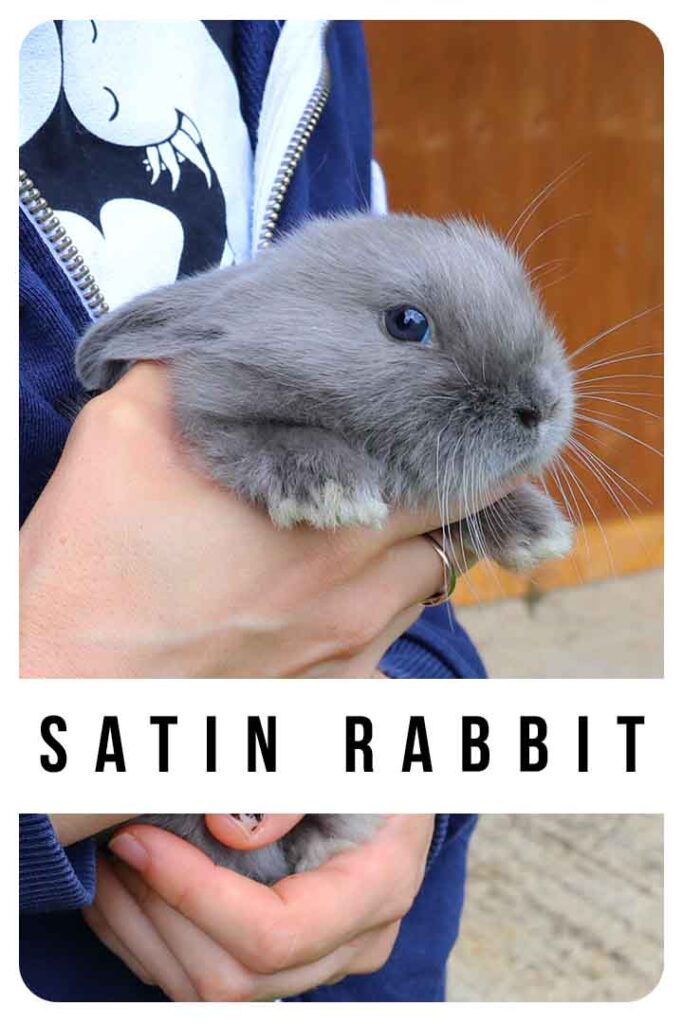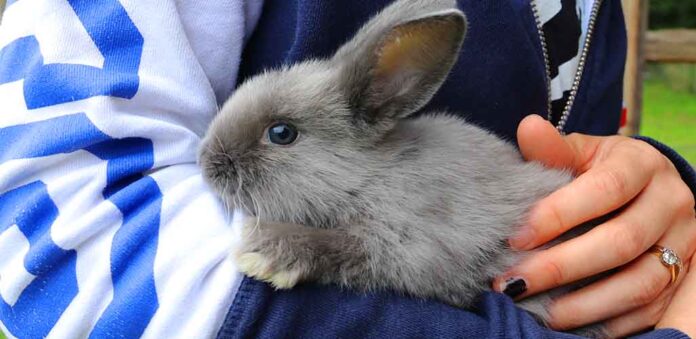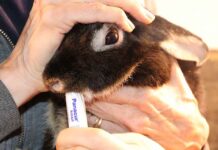The satin rabbit is one of my all time favorite breeds. From their sweet and docile nature to their semi-translucent, practically iridescent coat – this bunny is what my dreams are made of. And did I mention that they come in two different sizes? But I’m also worried about the long term health of this special breed. Join me now to see what I mean, and find out if a satin rabbit could be the perfect pet for you too.
- What is a satin rabbit?
- Satin rabbit colors and appearance
- How big do satin rabbits get?
- Satin bunny temperament
- Are satin rabbits healthy?
- How long do satin rabbits live?
- Caring for satin rabbits
- Is a satin rabbit right for me?
- Similar breeds to the satin rabbit
What is a satin rabbit?
Satin rabbits and miniature satin rabbits are two of the pedigree bunny breeds recognized by the American Rabbit Breeders Association. Being pedigree rabbits means that each individual bunny has a recorded family tree of other satin or mini satin ancestors. And they qualify to take part in breed shows, like the one Zachary and his dad visit in our video above.
Both satin breeds are descended from the Havana rabbit breed. Standard sized satins can all trace their heritage back to a litter of Havanas born in 1934. Back then, the only thing which marked those kits out was a previously unseen genetic mutation, which made their hairs narrower than normal and with hollow sections inside. Those changes dramatically affected how their coat caught light, and gave them a unique sheen. Descendents from that litter were further developed to meet a new breed standard of perfection, and finally awarded their own pedigree status in 1956.
After that, the miniature satin rabbit was developed by breeding standard satins with smaller breeds, such as the Polish rabbit. The mini satin was awarded pedigree status in 2006.
Satin rabbit colors and appearance
Both sizes of satin rabbit have a ‘commercial’ body type, which means their body is about as wide as it is tall, all the way along. Not wishing to put too fine a point on it, but they ought to look meaty! Satins also have low-set heads, ears that stand up, and roll back fur. Roll back fur is easy to stroke in the wrong direction, and rolls back to its natural position gently, rather than snapping back instantly.

The american satin rabbit breed standard recognizes 11 color categories:
- black
- blue (like the satin rabbit kitten in our photos here)
- californian (which means white with black patches on the ears, nose and feet)
- chinchilla (where each hair has bands of light and dark gray on its shaft)
- chocolate
- copper (where their coat contains a mix of black and red pigmented fur)
- otter (which is a pattern group made up of four possible colorways: black, chocolate, blue, and lilac)
- red
- siamese (a siamese satin rabbit has ombre shading at their points, like a Siamese cat)
- broken (which means any of the colors above, plus white patches)
- and white.
Miniature satins come in all the same colors, plus some bonus possibilities introduced by the other small breeds used during their development:
- chocolate agouti (which is lighter than the non-agouti chocolate coat)
- himalayan (like which is like the californian coat, but blue, choco and lilac patches are also accepted)
- opal
- silver marten
- squirrel
- and tortoise.
How big do satin rabbits get?
Satin rabbits are a medium sized bunny. When they are fully grown, they weigh 8.5 – 11lbs. In rabbits, it’s usually the females (does) which weigh the most, and the males (bucks) which weigh the least.
Miniature satin rabbits are less than half the size of a standard satin. They weigh just 3 – 4.5 lbs when they are fully grown.
Satin bunny temperament
Satin rabbits found fame for their novel, eye-catching coats. But they owe their enduring popularity to their charming temperaments. Satin rabbits of both sizes are generally described by their owners as being calm, friendly, and tolerant of being petted and handled. Their sweet nature has probably developed along with their coat – their beautiful fur made them more desirable as pets, so breeders were more likely to breed from does and bucks with personalities which made them well suited to living with families.
A great temperament isn’t innate and guaranteed just because you’ve chosen a satin rabbit though. You’ll have an important role to play in building up their confidence around people while they’re still a kitten. This process is called socialization: gently interacting with and handling your baby bunny every day, and making the experience a positive one through liberal use of treats.
Finally, satin rabbits aren’t just well disposed to be friendly, they’re clever too! These smart bunnies can be trained to use a litter box, taught instructions like coming to the sound of their name, and even learn simple tricks using positive reinforcement training.
Are satin rabbits generally healthy?
Unfortunately, their desirability as pets hasn’t just influenced the satins’ temperament. Satin rabbits in both sizes are notably more flat-faced than wild rabbits, and even than the Havana rabbits they’re descended from. This change has been driven by human perceptions of what is cute. Flat faced animals look more baby-ish and cute to us even when they’re fully grown. But sadly, the changes in the skull shape of flat-faced rabbits also makes them more prone to:
- Breathing problems
- Heatstroke
- Overgrown teeth
- Distortion of the tear ducts
Besides these problems, satins can also encounter the health problems common to all rabbit breeds, such as:
How long do satin rabbits live?
A well cared for pet rabbit should reach at least 8 years old. And some lucky bunnies even make it to 12 years old. This is true of satins and mini satins too.
Unfortunately though, one survey of pet rabbit life expectancy conducted by studying veterinary clinic records found that pet bunnies are frequently failing to reach this age range. In fact, they were only living for 4 to 5 years, on average. The researchers speculated that this was because many owners underestimated the complexity of owning a pet rabbit before getting one, or didn’t recognize the warning signs when their rabbits were ill.
Four of the most effective ways to make sure you rabbit lives as long as possible are to:
- Interact with and handle them every day.
- Feed them an appropriate diet.
- Vaccinate them against preventable diseases.
- Take them for routine check ups with a veterinarian every year.
Caring for satin rabbits
Now for the serious bit. Rabbits are engaging and charismatic little buddies in the right home. But it’s not unusual for people to underestimate how much space and attention they require! Take a look at this list of these things a satin rabbit will need, before you commit:
- Space
- Friends
- Frequently cleaning
- The right food
- Enrichment
Space
Rabbits need a roomy hutch with enough height and floor area to hop around in. They also need access to an outdoor run every day. Their habitat needs to be protected from predators and bad weather, and include opportunities to practise natural behaviors, such as hides, sleeping spaces, toys and things to gnaw on.
Friends
Rabbits are a social species. They form close emotional bonds to other rabbits, and isolation is very stressful for them. Your satin rabbit needs to live in a pair or a small group with other rabbits.
Cleaning
Lots of rabbit health problems, including viral, bacterial, fungal and parasitic infections are often attributable to living in a soiled hutch. They need their main toilet area cleaning every day, and the rest of their hutch cleaning every week. Training them to use a litter tray can speed this up immensely!
Food
Your rabbit’s diet should be mostly hay, supplemented with small quantities of rabbit pellets and fresh produce. Their digestive system is highly adapted to breakdown and digest a high-fiber, low-energy diet, and they rely on huge colonies of good bacteria living in their gut to help out. Feeding the wrong kinds of food can upset the delicate bacterial ecosystem in their gut and make them sick.
Enrichment
Rabbits are more sophisticated than we tend to give them credit for. They need both mental and physical stimulation from their environment, or they will get bored and stressed. For example you can give them:
- Your time and attention – a well socialized rabbit will seek out the attention of their owners and enjoy being petted, brushed, and hand fed.
- Simple training.
- Food treats hidden in paper bags stuffed with hay.
- Balls to play with.
- Platforms to survey their surroundings from (since rabbits are naturally a prey species, this helps a lot to prevent feelings of anxiety from being in captivity).
- Tunnels and boxes to hide in.
Is a satin rabbit right for me?
Satin rabbits are unique among the bunny breeds for their soft, translucent coat and sweet disposition. Provided they are socialized well from a young age, they are a good match for families with children, since they enjoy human interaction and being petted.
Like all rabbits, they are a significant commitment in terms of space, time and money. Their temperament is well-suited to first time rabbit owners, but it’s a good idea to ask yourself if the realities of bunny ownership are going to meet your expectations.
Finally, we recommend that before you buy a satin rabbit, you have a tactful but frank conversation with the breeder about the health of their parents. In particular, ask whether they have any history of the health problems known to be associated with having a flat face. If you can meet several breeders and buy your satin rabbit from parents with the longest face shape, all the better.
Similar breeds to the satin rabbit
If you can’t find satin rabbits for sale or adoption near you, or you’re not convinced this breed is quite your perfect match, these similar breeds might be closer to the mark:
- Californian Rabbit Breed – Your Guide To The California White Bunny
- Chinchilla Rabbit
- Jersey Wooly Rabbit
- Rex Rabbit Breed Guide
- Mini Rex Rabbit Breed Information Center: A Guide To The Mini Rex Bunny
Do you have a satin rabbit?
Do you already have a satin or mini satin rabbit? We’d love to know how you discovered this breed, and what your experience of owning one has been. Please let us know in the comments box down below!
References
- American Rabbit Breeders Association.
- American Satin Rabbit Breeders’ Association.
- Bourne. Hay for a healthy rabbit: the importance of appropriate feed. The Veterinary Nurse. 2013.
- Bourne. Physical and psychological needs of rabbits: a rabbit is not a cat. The Veterinary Nurse. 2013.
- Foote. Evidence-based approach to recognising and reducing stress in pet rabbits. Veterinary Nursing Journal. 2020.
- Kernot. Charities highlight brachycephaly in rabbits and cats. Vet Times. 2017.
- Harvey et al. What Makes a Rabbit Cute? Preference for Rabbit Faces Differs according to Skull Morphology and Demographic Factors. Animals. 2019.
- O’Neill et al. Morbidity and mortality of domestic rabbits under primary veterinary care in England. Vet Record. 2020.
- Parr & Holt. The effects of routine veterinary appointments on rabbit welfare. British Veterinary Nursing Association Congress. 2019.
- Rioja-Lang et al. Rabbit welfare: determining priority welfare issues for pet rabbits using a modified Delphi method. Vet Record Open. 2019.















I rescued what I believe is an adolescent solid black satin. Previous owner said 4 months old, Humane society Dr who spayed her said 1 year. She is 7lbs so I believe she is somewhere in between. She was in a 2×2 glass cube at the HS center with tons of barking dogs around he. She was sprawled out and calm considering her loud surroundings. I could give her the space, good hay and food she needed. I figured my house had to be better than that place. She was a single bunny before so I plan on only having her. She has her own bedroom and twice a day I let her run the house. She is doing pretty well, but now that she is comfortable, she is being a little bossy. I don’t mind the nose nudging, but the ankle bites are becoming frequent. I have had rabbits for years, but my Flemish was not a biter. Any advice on how to correct ankle nibbles? My kids are not loving that so they are avoiding her now. She is very smart. Females can be territorial so it could be she thinks she owns the house now. Advice appreciated. Thx.